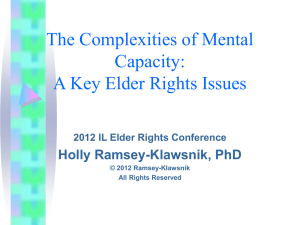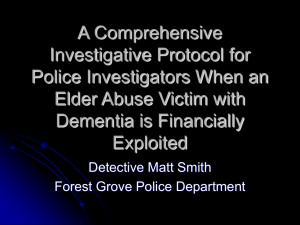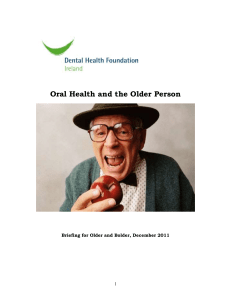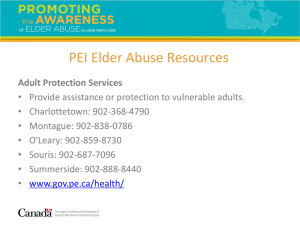Age Action
advertisement
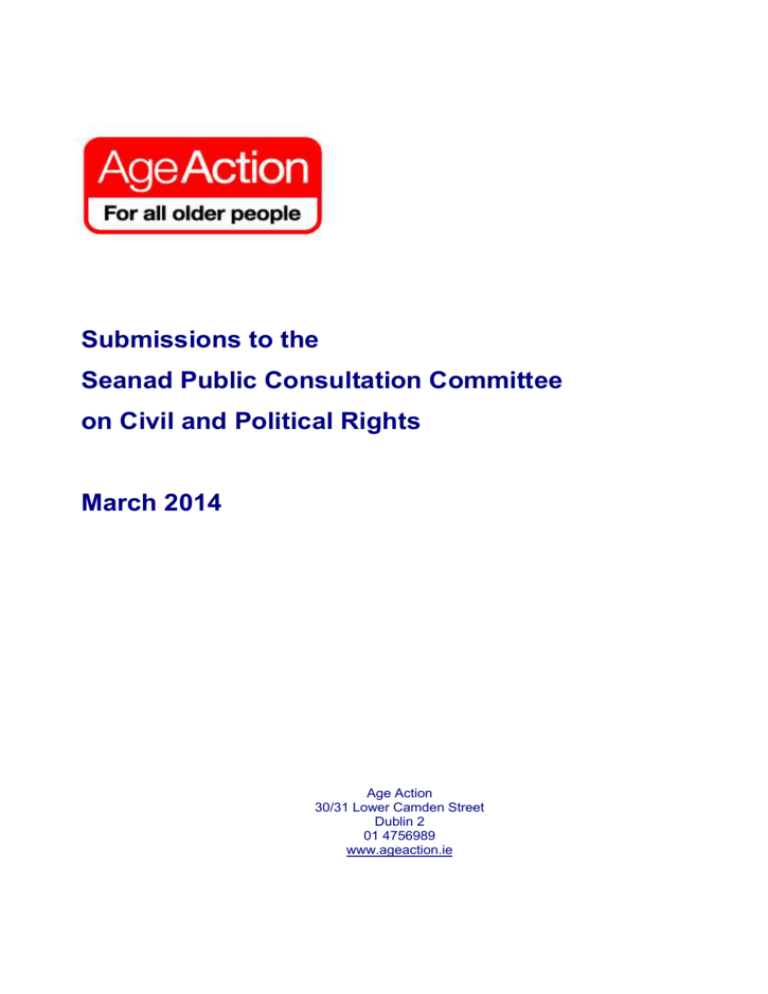
Submissions to the Seanad Public Consultation Committee on Civil and Political Rights March 2014 Age Action 30/31 Lower Camden Street Dublin 2 01 4756989 www.ageaction.ie 1. Introduction Age Action is a national non-government organisation that campaigns for better policies and services for older people. Since our foundation in 1992 we have worked to empower older people to live full lives as actively engaged citizens; helping to secure their right to comprehensive high quality services according to their changing needs. We encourage a move away from viewing older people as passive recipients of welfare to older people as rights holders, a group that are entitled and participating. We welcome this opportunity to make a submission to the Seanad Public Consultation Committee (SPCC) on the issue of Civil and Political Rights. We have previously engaged with this committee on ‘The Rights of Older People’ and welcome the fact that the report of this process urged “the Government to advance the case for drafting a new UN Treaty on the Right of Older People”.1 The remainder of our document is set out as follows: Ageing and Older People in Ireland Key priorities and challenges in complying with Ireland’s obligations under ICCPR Concluding comments 2. Ageing and Older People in Ireland There is no single definition of an ‘older person’ however the chronological age definition of 65 years and over is often applied and generally accepted. Currently, 11.7%2 (535,393 persons) of the population are aged 65 years and over. This percentage is expected to increase significantly in the future as like most countries we are experiencing rapid population ageing. This population ageing is largely a result of increased life expectancy. Over the last 100 years, life expectancy has risen from 49 years to 80.1 years. Future projections show increases to 85.7 years by 2050 and up to 91.4 years by 2100 (UN, 20133). The most significant increase will be in the number of people living beyond 80, where this age group is expected to quadruple from 110,000 in 2006 to 440,000 by 2041 (CSO, 20074). As a result, the population aged 65 years and over in Ireland is expected to reach 1.1 million by 2036 and between 1.3 and 1.4 million by 2041or 22% of the total population (CSO, 20125). Living well for longer is a bounty and we should celebrate how improvement in standards of living, better health in early years and increased education levels (WHO, 20026) have resulted in this demographic shift. It does however have significant implications for all-aspects of society. Notable are concerns over ensuring income security and continued investment in pension systems and equal access to quality healthcare as well as concern for the large sector of the older population that is vulnerable to neglect, 1 Seanad Public Consultation (2012) Report on the Rights of Older People. Downloaded from: http://www.oireachtas.ie/parliament/media/michelle/FinalReport1.pdf 2 Central Statistics Office (2012) Census 2011: Profile 2- Older and Younger. Downloaded from: http://www.cso.ie/en/census/census2011reports/census2011profile2-olderandyounger/ 3 United Nations (2013) World Population Prospects. The 2012 revision. Downloaded from: http://esa.un.org/unpd/wpp/Documentation/pdf/WPP2012_%20KEY%20FINDINGS.pdf 4 Central Statistics Office (2007) Ageing in Ireland. Dublin: Stationary Office. 5 Central Statistics Office. (2012a). This is Ireland - Highlights from Census 2011. Dublin: Central Statistics Office. 6 WHO (2002) Active Ageing: A Policy Framework. Downloaded from : http://whqlibdoc.who.int/hq/2002/who_nmh_nph_02.8.pdf 1 isolation and abuse (UNFPA, 20127). These issues underscore the urgent need for comprehensive human-rights based legislation as well as policies and services to guarantee older people’s inherent dignity and ensure the enjoyment of all their rights (UNFPA, 2012). The publication of the Assisted Decision-Making (Capacity) Bill 2013 is a welcome development which, following enactment should provide an improved legal framework for supporting people to exercise their legal capacity. The legislation will affect the tens of thousands of older people living with dementia, approximately 42,000 people (Cahill et al, 2012 8). Alongside population ageing this figure is expected to more than triple by 2041 to 140,000. The prevalence of dementia in long-term residential care should also be noted. Approximately 5% of the population aged 65 and over are resident in long-term care settings. The Department of Health’s official statistics for 2012 shows that 34.4% of long-stay beds were occupied by people whose medico-social status was described as ‘dementia’ (DOH, 20149). However, a recent review of dementia care (Cahill et al, 2012) estimates this figure to be far higher at 14,000 people, which means that approximately two-thirds of all nursing home residents are living with dementia. Again this raises concerns over the lack of robust legislation for people in residential care who need support around decision-making. The profile of the older population is also changing. Traditionally migrants have tended to be younger people however Census data from 2011 shows that the number of non-Irish born people aged 65 years and over increased by 27% in recent years to 19,200 people. 3. Key priorities and challenges in complying with Ireland’s obligations under ICCPR 3.1 Mental capacity/assisted decision making Article 2 - Obligation to implement the provision of the covenant (Convention on the rights of people with disabilities) Article 16 – The Right to be Recognised as a Person before the Law We welcome the progress made on the issue of capacity and assisted decision making through the publication of the Assisted Decision-Making (Capacity) 2013 Bill. The provisions of this legislation will have significant and far reaching implications for thousands of older people, among them the 42,000 people living with dementia (Cahill et al, 2012 10) as well as older people experiencing mental health problems, intellectual disabilities or those requiring support in decision-making due to stroke or other illness. The proposed legislation will replace the current wards of court and enduring power of attorney 7 UNFPA and HelpAge International (2012) Ageing in the 21st Century; A Celebration and a Challenge. New York and London. 8 Cahill, S. O’Shea, E. and Pierce, M. (2012) Future Dementia Care in Ireland. Download from: http://www.icsg.ie/sites/www.icsg.ie/files/personfiles/guide_booklet1_future_dementia_care_in_ireland_0.pdf 9 Department of Health (2014) Long-Stay Activity Statistics 2012. Download from: http://www.dohc.ie/publications/pdf/longstay2012.pdf?direct=1 10 Cahill, S. O’Shea, E, and Pierce, M. (2012) Creating Excellence in Dementia Care. Dublin and Galway: TCD and NUIG. Downloaded from: http://www.icsg.ie/sites/www.icsg.ie/files/personfiles/guide_booklet1_future_dementia_care_in_ireland_0.pdf 2 systems which operate through the Courts Service. The majority of wardship cases relate to older people, for example 32.5% of active wardship cases in 2012 were referred under the category ‘elderly mental infirm’ (Court Service, 201211). Under the current status approach to capacity assessment it can be a dramatic, powerful and a potentially devastating action to remove a person’s right to make decisions (O’Connor et al, 200912). This reality compounds the need for the full implementation of assisted decisionmaking legislation which respects and protects the person’s will and preference. 3.2 Article 2 – Obligation to implement the provision of the covenant 3.2.1 “Treatment and protection of elderly in long-term care homes/patients in resident health institutions” (p: 9) This section of the Fourth Report outlines the provision for the registration and inspection of designated centres for older people (nursing homes), both private and public. The development of 32 standards and the independent inspection of all public, private and voluntary nursing homes and residential care services for older people by the Health Information and Quality Authority13 were welcomed. A benefit of this system is not only that minimum standards are set but ensures transparency and accountability. The HIQA inspection reports can also facilitate informed choice when a person is choosing a residential care placement. Far more people receive care in the community than they do in residential care settings. Formal services include those run by voluntary organisations, the public sector and private companies. We therefore need to determine how we define long-term care. The WeDO coalition of NGO’s from across Europe identifies long-term care services as those that “can be delivered in various settings spanning the continuum from the beneficiary’s home to intermediate care and (semi-) residential facilities. (WeDo, 201214). This is important if we look at the number of people who need health and or social care. The Report of the Working Group on Long Term Care (2008 15) states that in 2012, 41,700 people aged over 65 years would require moderate care supports, 18,000 would need high care support and 40,200 would need continuous care, a total of 99,900. As a result of population ageing this figure is expected to increase. Most of this care will be provided in the home, often by private home care agencies. However, standards and regulation which were developed and implemented in the nursing home sector have not been replicated in the community. Currently there is no registration requirement to set up as a home care provider. The 11 Court Service (2012) Annual Report 2012. Download from: http://www.courts.ie/Courts.ie/library3.nsf/(WebFiles)/87BE463114EF96FF80257BA20033953B/$FILE/Courts%20Ser vice%20Annual%20Report%202012.pdf 12 O’Connor, D. Purves, B. and Downs, M. (2009) Decision-making in Dementia; towards a social model of understanding. In D. O’Connor and B. Purves (eds) Decision-making, Personhood and Dementia .London: Jessica Kingsley Publishers. 13 Health Information and quality Authority (2009) National Quality Standards for Residential Care Settings for Older People in Ireland. Dublin: HIQA. Downloaded from: http://www.hiqa.ie/publication/national-quality-standardsresidential-care-settings-older-people-ireland 14 WeDO (2012) European Quality Framework for Long-term Care Services. Download from: http://wedo.tttp.eu/system/files/24171_WeDo_brochure_A4_48p_EN_WEB.pdf 15 Department of Health (2008) Long-term Care Report. Downloaded from: http://www.dohc.ie/publications/pdf/long_term_care_report.pdf?direct=1 3 delivery of home care is largely unregulated. The NESC (201216) note that there are a variety of draft standards to promote quality services for home care. Some of these are being implemented, but they either cover only a proportion of home care, or are implemented on a voluntary basis. The NESC note that a recent Law Reform Commission report (Law Reform Commission, 2011) on regulation of home care providers includes specific guidance on how the Health Act 2007 can be amended to allow for this. A poorly regulated market for the provision of home care, at a time of population ageing with rising demand, must be addressed. We need to ensure a quality service particularly as those who are receiving care are in a more vulnerable situation (NESC, 2012). The NESC report (2012) comments on the ability of existing standards framework to prevent abuse and serious harm in the area of home care. They conclude that “a legislative underpinning to these standards, and inspection to ensure they are met, would help to improve the quality of all types of home care delivered, rather than a proportion, as is currently the case. This will become increasingly necessary in the future, with more older people likely to be cared for at home, in line with both Government policy and the wishes of older people”. 3.2.2 Policy on elder abuse Elder abuse is a serious societal issue affecting thousands of older people each year. The most recent prevalence study on elder abuse undertaken by the National Centre for the Protection of Older People in UCD17 found that 10,201 people in a year experience at least one of five forms of elder abuse (physical, psychological, financial/material, sexual abuse and neglect). This figure is similar to other international prevalence studies. This prevalence statistic however does not include people living in long-term care settings and the study did not include people with capacity issues, the figure could be higher. In the section of the Fourth Report ‘Treatment and protection of elderly in long-term care homes’ it outlines policy in relation to elder abuse which includes a description of HSE staffing structures including the Protection of Older Person’s Senior Case Workers (SCW) service. The Review of Protecting our Future; report of the working group on elder abuse (2009) identifies concerns with the efficiency and effectiveness of this HSE service. For instance, the review states that “The SCW role is not fully integrated with other HSE services for older people across the four HSE regions. This means that many SCWs operate in isolation from other services for older people and lack protocol-based access to medical and other services”. The Review also states that: “The under-developed nature of services for older people in the HSE constrains the ability of the SCWs to connect more widely in the HSE”. There was also concerns expressed over supervisory arrangements for the SCWs where the Review states that “All of the SCWs are social workers but most do not have professional supervision arrangements”. The Review identified only five instances where SCWs were supervised by a senior social worker which has implications both for the management of reported cases and for individual SCWs. 16 NESC (2012) Quality and Standards in Human Services in Ireland: Home Care for Older People. Downloaded from: http://files.nesc.ie/nesc_reports/en/NESC_130_Home_Care_Main_Report.pdf 17 Naughton, C. Drennan, J. Treacy, P. Lafferty, A. Lyons, I. Phelan, A. Quin, S. O’Loughlin, A. and Delaney, A. (2012) Abuse and Neglect of Older People in Ireland. Dublin: UCD. Downloaded from: http://www.ncpop.ie/userfiles/file/Prevalence%20study%20summary%20report.pdf 4 The Fourth Report states that there are 32 SCW and 4 Dedicated Elder Abuse Officers working throughout the HSE. However, The Review of the Recommendations of Protecting our Future (DOH, 200918) states that there were only 27 case workers in place at the time of the review. A follow-up by Age Action to the HSE in July 2013 found that there were only 28 case workers in post. In relation to the Dedicated Officer roles the HSE’s Elder Abuse Service Plan for 201119 shows that one of these positions was vacant in 2011 and a follow-up with the HSE in July 2013 found that two of these posts are currently vacant. The moratorium on recruitment and promotion introduced by Government in 2009 (as outlined in pages 4 and 5 of the Fourth Report) allows certain exemptions in Health sectors. This however, does not appear to apply to the elder abuse service. The staffing structures to respond to suspected cases of elder abuse are not unpinned by legislation which we feel allows for the dilution of the service when resources become stretched. 4. Concluding Comments The concerns raised in this submission must be viewed within the context of population ageing, where age can be a ground for discrimination but compounded when combined with other grounds such as gender, disability, ethnicity etc. We are conscious of the lack of focus on ageing generally throughout the Fourth Report, for example the section on Article 10 – Humane Treatment of Persons Deprived of their Liberty makes no reference to the growing population of older prisoners, with reported increases in this group from 199 people in 2007 to 335 in 201220. As people get older they are more likely to be at risk of co-morbidity and multi-morbidity with its associated higher risk of disability21 and mental health problems (EHLEIS, 201322) which is no different for someone who is living in the community or in prison however a person’s ability to have these needs addressed in a timely and accessible way may be hampered in a prison environment. For further information on this submission please contact Naomi Feely Senior Policy Officer on 01-4756989 or email socialinclusion@ageaction.ie. 18 Department of Health (2009) Review of the Recommendations of Protecting our Future: Report of the Working Group on Elder abuse. Download From: http://www.dohc.ie/publications/pdf/pof_review2010.pdf?direct=1 19 HSE (2012) HSE Elder Abuse Services 2011. Downloaded from: http://www.hse.ie/eng/services/Publications/services/olderpeople/Elder%20Abuse%20Report%202011.pdf 20 See: http://www.iprt.ie/contents/2462 21 The most frequently reported disability type for older people is mobility and dexterity with 70% of those 65-74 years and 83% of those 75+ years reporting this type of disability (Murphy, 2012). 22 European Health and Life Expectancy Information System EHLEIS (2013) EHLEIS country report: life expectancy in Ireland. Issue 6, April 2013. 5

